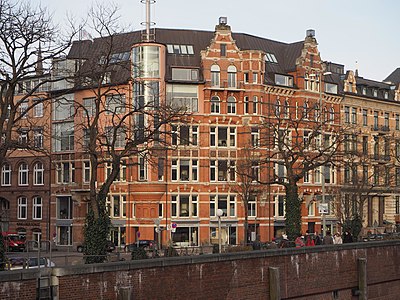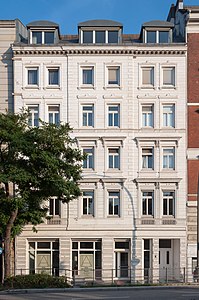Zippelhaus
The Zippelhaus was a historic building in Hamburg's old town . It is also the name of the street that now runs at the original location.
history
Old Zippelhaus
The building was built in 1535 in the immediate vicinity of St. Katharinen Church , one of the four parishes in Hamburg at the time. In 1604 the city of Hamburg gave the greengrocers from Bardowick the Zippelhaus "forever" for a small rent. These greengrocers used the building as a shop and warehouse. In addition, many Bardowick vegetable maids stayed overnight in the house, thus avoiding the tedious commute between their home and their place of work. The name of the Zippelhaus followed one of the most important products: the Zippel, the Low German word for onion.
The building was a narrow, one-story half - timbered building with horizontally mounted wooden shutters on the street side . The shutters could be folded down and used to sell the goods. The goods brought in by water could be unloaded on a specially designated landing place on the customs canal and transported to the Zippelhaus. After 139 years of existence, the old building had to be replaced by a new one in 1674 because it was in disrepair . Because of road construction work, this building was also demolished in 1888 after another 214 years. The Bardowick greengrocers, who originally rented the Zippelhaus forever, waived their tenancy rights beforehand. A Zippelhaus interest group was formed in Bardowick in 1889 , which acquired a warehouse at Deichstrasse 27, which was later also referred to as Bardowick Speicher . A memorial plaque still reminds of this today.
Today's development on the Zippelhaus street
The original location of Zippel home runs today at customs channel opposite the Speicherstadt street Zippelhaus that bears her name in honor of the historic building. There are now a number of houses from the late 19th century.
The Katharinenhof (former freight house) is located at Zippelhaus 1–2 . The original building from 1890/91 was designed by Hinrich Fittschen. From 1991 to 1993 the house, which was partially destroyed in the Second World War, was reconstructed and expanded.
At Zippelhaus 3 is the residential and commercial building Haus Rademacher , built in 1890/1891 according to plans by Carl Elvers for the publisher FW Rademacher . On its neo-renaissance facade, the multi-storey building is equipped with two figural baths on the first floor: Alois Senefelder , the inventor of lithography, and Johann Gutenberg , the inventor of letterpress printing. The figures indicate the purpose of the building as a printing and publishing house. The building is an example of the forerunners of the actual office building . The old mixed use of living and working in the community center still existed, but both shop and office operators and residents were already independent tenants.
To the northeast, the Transporthaus (Zippelhaus 4), the former Nobelshof (Zippelhaus 5) and the Zippelhaus 6 and 7 houses, which all come from the same construction period.
Katharinenhof
Zippelhaus 1–2
built in 1890/91House Rademacher
Zippelhaus 3
built in 1890/91Transport house
Zippelhaus 4
built in 1894Former Nobelshof
Zippelhaus 5
built in 1894/95
swell
- Franklin Kopitzsch , Daniel Tilgner (Ed.): Hamburg Lexikon. 2nd, revised edition. Zeiseverlag, Hamburg 2000, ISBN 3-9805687-9-2 .
- Ralf Lange : The Hamburg office building - architecture, history, monument . Hamburg 2015, ISBN 978-3-86218-067-7 .
Individual evidence
- ↑ Elke Schnee: ( Page no longer available , search in web archives: When the Bardowickers conquered Hamburg ) . In: Hamburger Abendblatt from December 3, 2005.
- ↑ Model New York: The office buildings . In: Welt Online from August 25, 2002, ISSN 0173-8437 .
Coordinates: 53 ° 32 ′ 46.6 " N , 9 ° 59 ′ 46" E






